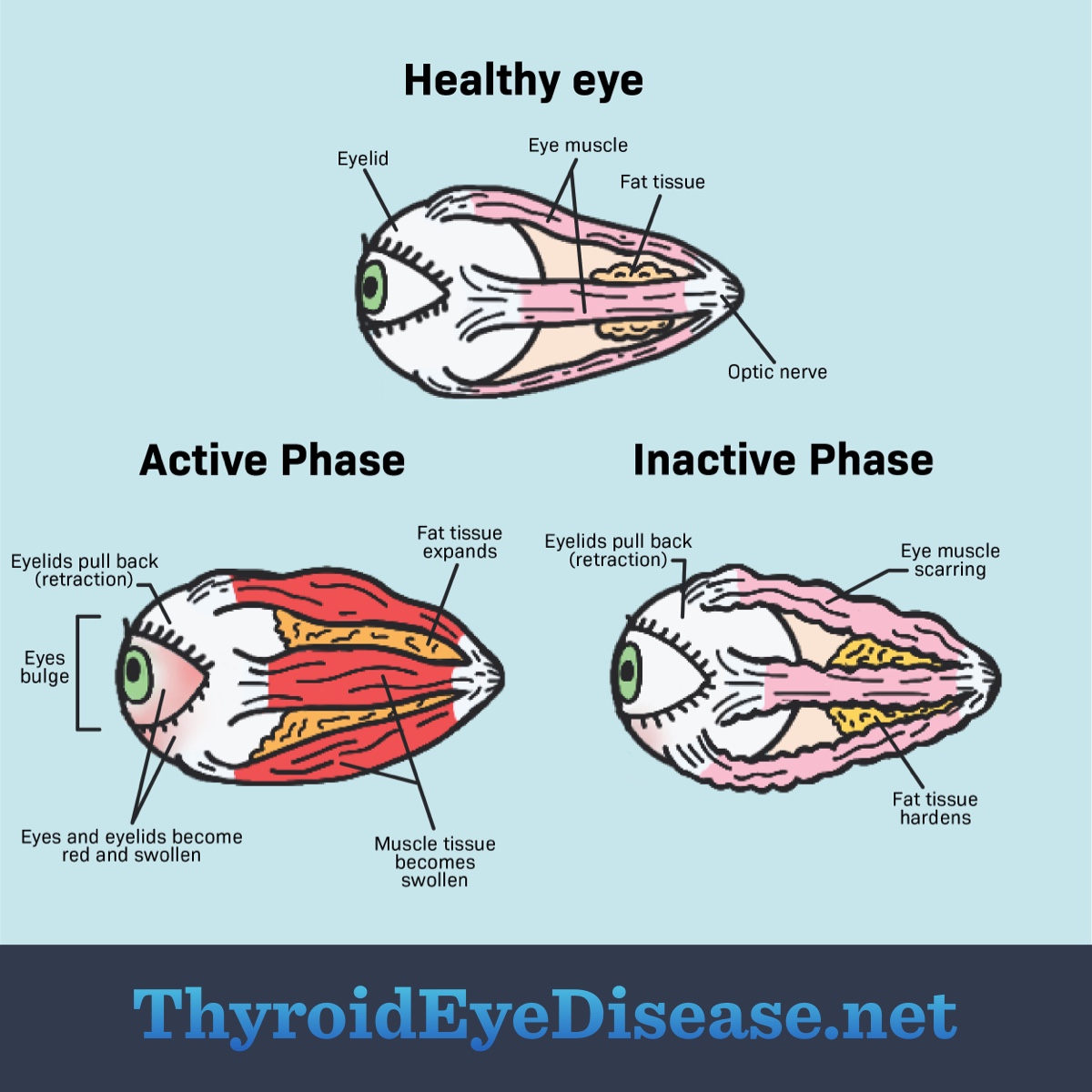What Are the Phases of Thyroid Eye Disease?
Reviewed by: HU Medical Review Board | Last reviewed: October 2021 | Last updated: September 2025
Thyroid eye disease (TED) is a progressive condition. This means it gets worse over time. There are 2 phases of TED: an active phase and an inactive phase. Each phase is different. Treatment goals for each phase are also different.1
Figure 2. Phases of TED
Active phase
You may hear your doctor call this phase the “acute” phase. This phase is when you will see the first signs of TED and when inflammation begins. Symptoms of TED appear suddenly and often get worse quickly.2
In the active phase, you may notice changes to your face and eye problems, including:2
- Swollen, puffy, red eyes and eyelids
- Dry, gritty eyes
- Bulging eyes that look like you are staring
- Eyelids pulling back (retraction and lateral flare)
- Double vision (diplopia, dip-low-pee-ah)
- Misaligned eyes that do not line up and point in different directions (strabismus, strah-biz-muss)
- Sensitivity to light
- Eye pressure or pain
In this phase, the muscle and fat tissue behind the eye swells, causing the eyes to bulge forward. This swelling can also cause changes in your vision.3
The active phase also causes tightening of the muscles and connective tissue around the eyes. This can pull your eyelids open, making them hard to close. If you cannot completely close your eyes, you may develop symptoms of dry eye.3
Over time, scarring of the tissues around your eye can also develop in the active phase.3
How long does the active phase last?
It is hard to know the exact timeframe for the active phase. However, doctors think it usually lasts 6 months to 2 years.1
This or That
Do you know the difference between the Active vs. Inactive Phases of TED?
Active phase treatments
The goal of treatment in the active phase is to reduce inflammation. Treatment includes:1,2
- Steroids, which are potent anti-inflammatory drugs
- Disease-modifying drugs that suppress the immune system when it is overactive
Supportive treatments for eye lubrication, pain, and discomfort are also commonly used in the active phase.2
Signs that the active phase has ended
Only a TED specialist can know which phase you are in, as well as the best treatment for you. There are some signs you can look for that may signal you could be entering the inactive stage of TED:2
- Redness and irritation of your eyes is decreased or gone
- Eye bulging or staring appearance has not gotten worse
- Swelling in and around your eyes has stopped or is slowing down
Inactive phase
In the inactive or chronic stage disease progression stops, but some symptoms can remain. Depending on the severity and length of time of the active phase, you may have scar tissue or problems with vision in inactive phase.2
If TED is left untreated, the scar tissue from the active phase can continue to cause damage to the eyes.3
Inactive phase treatments
Your doctor will wait until the inactive phase to perform surgery, if needed. Depending on the procedure needed, these are done to help you gain back function (vision) or to address the physical changes in your face. Surgeries common in this phase include:2
- Orbital decompression surgery
- Eye muscle surgery
- Eyelid repair
Can TED be cured?
TED is a chronic disease, meaning it generally lasts a person’s whole life. Symptoms of TED may slow down over time, but this does not mean the disease goes away. Even if you are in the inactive phase of TED, the disease is still there. It is possible for TED to flare up and for your symptoms to return.2
Impact of TED
TED is much more than a disease of the eyes. The effects from TED, during both the active and inactive phases, can impact all aspects of your life.
Changes to your appearance and vision with TED can be shocking and disrupting. Your mental health and self confidence can suffer.
Studies have shown that the symptoms and changes from TED can affect your quality of life. One Australian survey showed that more than 6 out of 10 people with TED said that changes to their appearance significantly interfered with their mental health. More than half of those surveyed in a separate study reported decreased self confidence due to TED.4
Visible or not, changes caused by TED play a major role in your quality of life. Being open and honest with your doctor helps with getting the answers and treatment you need. It is okay to ask for a second opinion or to look for a TED specialist. Be an advocate for yourself. Your symptoms are real and should not be overlooked.
Also, understanding more about the phases of TED can help you navigate through some of the unknowns that TED presents. Use this knowledge to help you get the most out of your care and to live the life you want.
